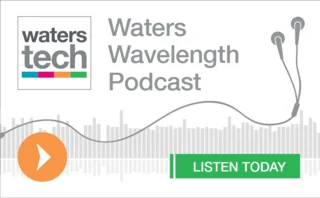Euronext microwave link aims to cut HFT advantage in Europe
Exchange plans to level playing field between prop firms and banks in cash equities with cutting edge tech.

Euronext is planning to partner with a low-latency telecoms provider to launch a high-speed microwave connection for banks between London and its main data center in Italy, according to three sources familiar with the project.
Dealers currently struggle to compete with high-frequency trading firms (HFTs) that gain a latency advantage from microwave technology when trading European cash equities between London-based dark pools and Euronext’s exchanges.
A bank source that has heard Euronext’s pitch says it is looking to work with third-party microwave provider McKay Brothers to level the playing field by giving dealers access to the technology at a more affordable cost. Risk.net, WatersTechnology’s sibling publication, understands the service is planned to launch in the summer.
Stephane Tyc, co-founder of McKay Brothers, says what Euronext is doing is “not a simple resale” of space on the spectrum to banks, and is “actually super novel”, but declined to give further details.
Offering this service is a strong gesture to show they are still committed, even if all the data center infrastructure is now in Italy
Chief executive of a trading technology vendor
A source at a non-bank market-maker is also aware of Euronext’s plans, but it’s not known exactly how many banks are involved, or whether any have officially signed up for the service. Euronext declined to comment.
The need for the connection is said to stem from the decision to shift Euronext’s data center from Basildon, near London, to Bergamo outside Milan in 2022.
HFTs employ powerful computers to transact a large number of orders at high speeds to exploit tiny pricing differentials in stocks between venues. While banks predominantly use slower fiber to connect to venues, HFTs tend to utilize faster microwave technology.
When banks trade cash equities, they may first try to find liquidity in London-based dark pool multilateral trading facilities (MTFs), then go for the remaining fill on the exchange’s lit book.
When Euronext’s data center was still in London, the dark pool and exchange prices would catch up with each other in roughly 0.5 milliseconds, but the geographical shift to Bergamo has introduced additional latency and means a bank’s order takes eight milliseconds to go from London’s dark pools to Euronext’s data center in Italy using fiber.
But if more sophisticated participants see price changes on the London dark pool, for example, they can get to Euronext’s exchange data center in Bergamo twice as fast using microwaves and potentially trade ahead of the banks.
The HFT advantage also goes the other way: a study by Euronext shows that users of microwave networks receive price updates from the data center in Italy 4 milliseconds in advance of participants in the London dark pools that are using optical fiber.
An executive at a dark pool competitor believes Euronext has been forced into offering microwave to compensate for the latency introduced following the Bergamo relocation. “That becomes a latency arbitrage opportunity when you have to do a round trip to get up-to-date market data from Italy,” they say.
The chief executive of a trading technology vendor agrees, saying, “With the move from Basildon to Bergamo, the challenge for them was to guarantee a certain level of infrastructure for some of their members. Offering this service is a strong gesture to show they are still committed, even if all the data center infrastructure is now in Italy.”
Faster speed… at a price
The microwave connection is set to run from the LD4 data center in Slough, near London, to Bergamo. LD4 is the data center where dark pool venues such as Cboe and Aquis are predominantly based, with banks, brokers and prop trading firms also having a presence.
The bank executive says the microwave offering would be for both market data and order entry. “Order entry is probably equally as important, if not more important, because you need to see your market data and need to react to it faster,” they say.
It is not known how the service will be priced, but McKay’s Tyc and the bank source say microwave can currently be 10 times more expensive than fiber.
The bank executive says the “Euronext-McKay partnership” will still be more expensive than existing fiber, but will be “fully resilient”. That is because the plan includes a fiber backup in case the microwave signal fails, for instance due to adverse weather conditions.
“When you’re sending out an order, you’ll be sending out effectively two messages. One via microwave and one by fiber. The microwave will get there faster, but if it gets lost in transit, the fiber one will be picked up at the end,” says the exec.
Although HFTs enjoy an advantage in microwave technology, the bank executive says dealers may still be put off adopting microwave because of its higher cost. “Even through a third-party provider, the costs are going to be much higher than doing a fiber network,” they say.
However, the bank executive says that not all its clients necessarily need access to low-latency execution, and given the “high technical challenges” of moving to a microwave service, the attractiveness of the proposition will depend partly on each banks’ client base.
“It comes down to a cost-benefit of the increased fill rate you’re going to get when you’re looking to target a given quote—and you get there a little bit faster—versus your wider execution strategy,” the exec says.
An electronic trading executive at a venue says that while adopting microwave technology in Europe will confer a “significant advantage” on banks to improve their execution quality, HFTs will still have the upper hand.
“There are people who are in this business on the HFT side who are dedicated,” says the electronic trading executive. “If you look at the jobs that some of these [HFT firms] hire for, they say, ‘Looking for a person who’s willing to go up and down telephone poles.’ So that gives you an idea of the level of commitment HFTs have that banks are not going to have. So HFTs will probably always be slightly faster.”
The move comes as Euronext has launched its own dark pools in Brussels, Paris, Milan, Oslo, Lisbon, Amsterdam and Dublin. Deutsche Börse is following in its footsteps, with plans to launch a midpoint dark pool in November.
Additional reporting by Nathan Tipping and Mauro Cesa
Editing by Kris Devasabai
Further reading
Only users who have a paid subscription or are part of a corporate subscription are able to print or copy content.
To access these options, along with all other subscription benefits, please contact info@waterstechnology.com or view our subscription options here: http://subscriptions.waterstechnology.com/subscribe
You are currently unable to print this content. Please contact info@waterstechnology.com to find out more.
You are currently unable to copy this content. Please contact info@waterstechnology.com to find out more.
Copyright Infopro Digital Limited. All rights reserved.
As outlined in our terms and conditions, https://www.infopro-digital.com/terms-and-conditions/subscriptions/ (point 2.4), printing is limited to a single copy.
If you would like to purchase additional rights please email info@waterstechnology.com
Copyright Infopro Digital Limited. All rights reserved.
You may share this content using our article tools. As outlined in our terms and conditions, https://www.infopro-digital.com/terms-and-conditions/subscriptions/ (clause 2.4), an Authorised User may only make one copy of the materials for their own personal use. You must also comply with the restrictions in clause 2.5.
If you would like to purchase additional rights please email info@waterstechnology.com
More on Emerging Technologies
This Week: Startup Skyfire launches payment network for AI agents; State Street; SteelEye and more
A summary of the latest financial technology news.
Waters Wavelength Podcast: Standard Chartered’s Brian O’Neill
Brian O’Neill from Standard Chartered joins the podcast to discuss cloud strategy, costs, and resiliency.
SS&C builds data mesh to unite acquired platforms
The vendor is using GenAI and APIs as part of the ongoing project.
Chevron’s absence leaves questions for elusive AI regulation in US
The US Supreme Court’s decision to overturn the Chevron deference presents unique considerations for potential AI rules.
Reading the bones: Citi, BNY, Morgan Stanley invest in AI, alt data, & private markets
Investment arms at large US banks are taken with emerging technologies such as generative AI, alternative and unstructured data, and private markets as they look to partner with, acquire, and invest in leading startups.
Startup helps buy-side firms retain ‘control’ over analytics
ExeQution Analytics provides a structured and flexible analytics framework based on the q programming language that can be integrated with kdb+ platforms.
The IMD Wrap: With Bloomberg’s headset app, you’ll never look at data the same way again
Max recently wrote about new developments being added to Bloomberg Pro for Vision. Today he gives a more personal perspective on the new technology.
LSEG unveils Workspace Teams, other products of Microsoft deal
The exchange revealed new developments in the ongoing Workspace/Teams collaboration as it works with Big Tech to improve trader workflows.







